THE MECHANICS OF COORDINATION
(October, 2004)
By Noel Huntley, Ph.D.
The following description of the mechanics of coordination will extend well beyond physical mobility of humans, animals and insects, since we are dealing with the workings of nature's computer system. Consider an apparently simple (though technically very complex) motion of the human arm in some physical activity, such as cleaning one's motor vehicle. The arm is active at all the joints: shoulder, elbow, wrist, and fingers. Tensions appropriate to the movement are occurring in the muscles.
Now imagine freezing this motion (not physically) so that we have a cross-section of the distribution of tensions in the muscles. We have created a single static frame and we have eliminated time so that we can concentrate on the spatial relationship of the movements. To provide the tensions in the muscles there must be a causative pattern of nerve impulses. We have a static frame in which we can envisage a number of impulses sent to appropriate regions of the fingers, wrist, elbow and shoulder. Picture these as dots on a screen with concentrations of these 'bits' (as in computers) on different areas of the screen, keeping in mind the form of the arm. Thus we have a frozen position of the arm; a static frame represented by dots concentrated appropriately on the screen. What we want the reader to understand here is that this is information density in space. The computer expert will immediately know what this means. More explicitly Figure 1 shows a mass of dots covering other possible motions/tensions but the ones we want---the spatial frame dots---are in red. The blank dots represent other units for other learning patterns---other arm-motion patterns. In reality there would be millions of dots even for a simple movement.
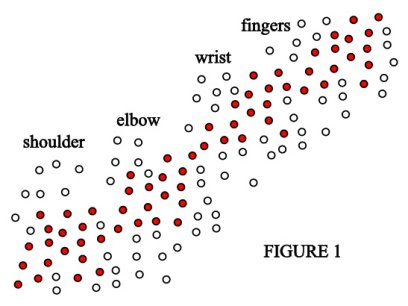 The
dots can be imagined as being connected by communication lines to the control
centre of the mind. If the number of communication lines (and dots or bits)
is made greater, then the information density is greater. This may be easier
to understand as we consider information density in time, particularly for
people who use a modem with their computer to go online, that is, on the Internet.
The baud rate is the number of pulses of electricity (bits) passing down the
telephone line per unit time. Each of those pulses is one bit of information---a
basic message element. The sequences of pulses are ordered; they are grouped,
that is, have patterns to represent letters, commands, instructions or concepts.
A 56K modem provides twice the information density in time as a 28K modem;
thus it is twice as fast.
The
dots can be imagined as being connected by communication lines to the control
centre of the mind. If the number of communication lines (and dots or bits)
is made greater, then the information density is greater. This may be easier
to understand as we consider information density in time, particularly for
people who use a modem with their computer to go online, that is, on the Internet.
The baud rate is the number of pulses of electricity (bits) passing down the
telephone line per unit time. Each of those pulses is one bit of information---a
basic message element. The sequences of pulses are ordered; they are grouped,
that is, have patterns to represent letters, commands, instructions or concepts.
A 56K modem provides twice the information density in time as a 28K modem;
thus it is twice as fast.
Returning to the mechanics of the arm action (cleaning the vehicle), we shall see that the learning-pattern programmes providing the dots on the screen have information density in both space and time. But let us stay initially with the spatial information density or dots on the frozen frame example in Figure 1.
Within the learning pattern we have a distribution of dots on the screen, corresponding to the active red bits (units), giving that particular configuration of the arm motion frozen in time---that is, one frame. Now since this movement, cleaning the car, is a simple one, it is a learned movement for any normal person. This means the dots on the screen are connected together. All the dots for the tensions in the fingers will be connected very thoroughly; not just their connections to the control centre but to one another forming one holistic whole for the finger group. Furthermore, dots for the fingers are also connected to the wrist dots---possibly a little less thoroughly than amongst themselves, depending on the ability of the person to make these movements, governed by practice.
What does a 'connection' mean. When two bits are connected in this manner it means their frequencies have been entrained, that is, aligned---put into phase, into resonance. They become one unifying dot, but they don't move into the same space. Their connection is provided by another bit---which has materialised/coalesced from the energy fields. This is pictured on another layer (referred to as inner-space or higher-dimensional or nested levels). This extra bit acts nonlinearly on the others.
If the red dots, in Figure 1, were not connected (unlearned) we would have to imagine the input---our sense of attention/intention and consciousness---having to consciously identify and span all these units simultaneously to activate them for even just the single frame. A difficult feat of concentration---there would be no accuracy. The red dots must be unified, which is what learning achieves.
Let us now explain this nonlinearity for this single frame of patterned bits of information. Note that much of this has been explained in other articles on physical mobility with appropriate diagrams.
Imagine the screen again, with the dots, and what it means. Now picture a second screen or layer overlayed on the first, not quite touching. See Figure 2. We have already pointed out that all the red dots in this frame 1 are interconnected for a learned sequence (in space or time or both) but that the unification (from this interconnection) does not occur in layer 1. Let us imagine initially, as an experiment, in layer 2 we place one red dot and connect it to all the red dots in frame 1. We now see that frame 2 gives the complete unity of frame 1. Consciousness need only think 'one', meaning a singular action concept to produce the full frame. The unity does not occur in layer 1; the bits must be free in this layer.
 Note
that all the bits are coloured red since these are the programmed bits for
the movement. A programme is simply a group of bits set in sequence or acting
simultaneously. This is not shown, of course, as it would have to be immensely
complex just to make any sense. It is essential, however, that there is a
gradient from layer 2 unity, to the separateness (of dots) in layer 1---see
Figure 3. The Figure 2 configuration is therefore not correct. Thus we must
envisage many layers, or strata, between these two layers 1 and 2. Why is
this? Figure 3 is a schematic of a learning pattern structure. Note that the
layout in Figure 1 of red dots now corresponds to level D only in Figure 3.
Also realise that we are linking together the learning patterns for the fingers,
wrist, elbow, and shoulder, since we are considering a learned movement. Thus
we have one learning pattern, which is a combination of the sub-learning patterns
(of, for example, the parts: fingers, wrist, elbow, and shoulder).
Note
that all the bits are coloured red since these are the programmed bits for
the movement. A programme is simply a group of bits set in sequence or acting
simultaneously. This is not shown, of course, as it would have to be immensely
complex just to make any sense. It is essential, however, that there is a
gradient from layer 2 unity, to the separateness (of dots) in layer 1---see
Figure 3. The Figure 2 configuration is therefore not correct. Thus we must
envisage many layers, or strata, between these two layers 1 and 2. Why is
this? Figure 3 is a schematic of a learning pattern structure. Note that the
layout in Figure 1 of red dots now corresponds to level D only in Figure 3.
Also realise that we are linking together the learning patterns for the fingers,
wrist, elbow, and shoulder, since we are considering a learned movement. Thus
we have one learning pattern, which is a combination of the sub-learning patterns
(of, for example, the parts: fingers, wrist, elbow, and shoulder).
One can see that the single unit at A spans and integrates all other units. Similarly a unit at level B can be seen to span a region of units below it but not all. The two units at B have territories or control areas which overlap but that doesn't matter. They probably work this way to give a fine gradient rather than arranging the units as in the binary system. Figure 3 of course, is a flat 2D view of the units. In practice, for example, D would actually be a volume. Also keep in mind that in reality there are countless levels from A to D.
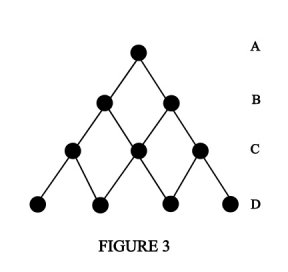
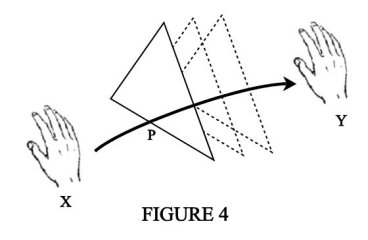
Figure 3 can be pictured as a pyramid. For a learned sequence, all the units (dots) are in resonance---have matching frequencies or fractions of frequencies. The single dot at the top is like the president of all the members below. Let us give a simple illustration of how this works spatially before we tackle the information density in time.
Figure 4 shows a simple hand motion---this is a learned movement (completed learning pattern). In this example the frozen spatial frame, described above, occurs at P. Note that it is at right angles to the path of the hand, which passes through time. That is, space is at right angles to time (4D time is at 90 degrees to each of the 3D spatial dimensions). The dotted triangles simply indicate that the spatial frames continue along the time path. At any instant, P in Figure 4, that particular spatial frame unifies all tensions in the arm/hand coordination. Note that this is only a diagram with the mind's learning pattern superimposed on the physical path.
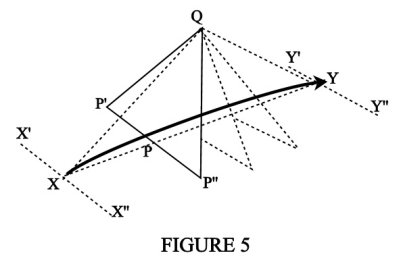
In Figure 5 we see the relation between the time frame and the spatial frames. Not only are the spatial frames unified but these spatial frames are then unified in time (over short intervals such as this). The spatial frames are repeated in time at a certain rate (frequency). The information rate gives the temporal information density, or information density in time. For a learned movement, which is what this is, all the spatial frames, QP'P", are interrelated or cross-referenced, that is, they form one whole at point Q (in time---the interval from X to Y). In effect, the 'pyramid' is holistic and, as we shall see, holographic. The full pyramid is bounded by points QX'X"Y'Y".
To clarify, the line P'P" is the same as layer1 (or the red dots in Figure 1) we mentioned earlier. As before, it is drawn lower dimensional, as a line for illustration purposes. When we referred to a nonlinear spatial frame, this is now above P'P". Thus P'P"Q is the full nonlinear spatial frame. The number of nonlinear spatial frames along XY is the frequency of the programmed energy and is proportional to the level of ability, or skill development.
We can now get an idea of the meaning of information density in time, which is the number of spatial frames P'P"Q from X to Y. The learning pattern for this movement is the whole pyramid QX'X"Y"Y'. The learning pattern does not distinguish between space and time. This means the density of information in space is the same as the density of information in time. Think of the pyramid as a whole block suspended in spacetime. The mind senses all this information in the learning pattern simultaneously but this is not the conscious mind. It is sensed in the margin of consciousness but the computations are quite unconscious.
We might wish to imagine the learning-pattern pyramid, Figure 5, that is, the full volume, as filled with red dots, implying the bits of information and all interrelated (for a learned movement). We can indicate at this point that if this learning pattern is coordinated with another learning pattern, say, in the other hand/arm, then the dots in the first pyramid, Figure 5, are connected to those in the second learning pattern of the other arm. But even each of these nonlinear structures are not connected 'linearly' as in Figure 6. They are again part of a larger nonlinear pyramid as in Figure 7.
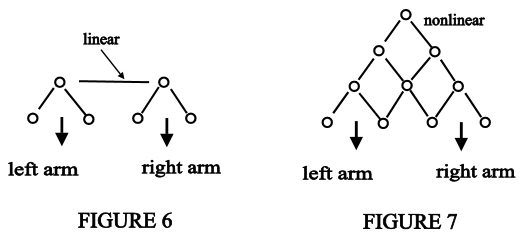
The higher the development, or skill, the greater the number of bits in the pyramid. As one considers the different strata in the learning pattern pyramid, the lowest level has the lowest frequencies, with increasing frequencies a we go up the gradient to the apex, the single unit at the top. This is based on information that the greater the unity of any energy (referred to as holistic), the greater the frequency of its oscillations. Note that the upper levels are further into inner-space or higher dimensions. To increase the information density in the learning pattern we must increase the number of bits and in turn the frequencies must be greater. Although we say that the frequencies increase up the pyramd, when it is learned and operating as one whole, this is the highest frequency and the lower ones would only become apparent if we broke down the whole into parts again and addressed the parts.
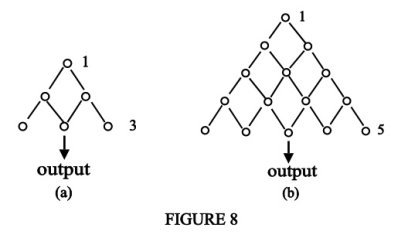
Figure 8 shows two learning patterns of different information density. They both do the same job but the larger one will do it better. Since there are more bits in the larger learning pattern there will be more communication lines and therefore more awareness and control of movements. We see that (b) has an amplification of 5, and (a) has an amplification of 3. This is due to the fact that the one bit at the apex integrates all the rest and the bottom line is the output. For a learned pattern all the oscillations of the units are synchronised forming a holistic learning pattern. This means one does not have to use the top unit only to activate the whole learning pattern. One can use any unit with this holistic system. Realise, consciousness already has these frequencies inherent in itself. This also means that the access method to this learning pattern is holographic. For example, if one is playing the keyboard, say, for a learned piece of music, one can take one's attention off the playing but when bringing it back, say, to strike a key harder, one can access the learning pattern at any interface level: any one finger, wrist, elbow, whole arm, or both arms simultaneously---any part or action concept within the whole will activate the whole, that is, keep the playing going. It is possible for the researcher to train himself or herself to observe this while executing a continuous skill, proving, to themselves, that the learning pattern is holographic---that it can be accessed (controlled) from any sub-part to the whole
The amplification mentioned above is holographic amplification, and this single factor is the basis of all skill and coordination ability in physical movements. In Figure 8, the holographic amplifications are 3 and 5. This is a difficult concept to grasp---it is not just a ratio increase, such as stepping up the leverage in a system or going into a higher gear in a motor vehicle, though these examples are relevant. The real difficulty is grasping how the input, which we can describe as consciousness, and an energy spectrum, 'dilutes' as the learning pattern expands. Clearly this input, consciousness, will decrease as skill improves. This is all the reader needs to know; and it is not necessary to become involved with the arithmetic. But in Figure 8 the output base of the triangle in (a) and (b) which is 3 and 5 units respectively may be doing the same job as one another. Now in (a) the input unit at the top is 1/3 of the output but in (b) it is 1/5. Therefore we see that less input is required even though there is an expansion of the learning pattern. The output is meant to be the same in this example, in which the input, in going from (a) to (b), has been reduced by the factor 3/5. Keep in mind the existence of enormous numbers of these bits.
We can now imagine all movements controlled by learning patterns. All tensions in muscles at any instance are cross-referenced; they are linked together---to the degree of the learning. It is important to understand that when any movements are made, all tensions that occur simultaneously and repetitively in the body with this movement, such as neck tensions, or even an eyebrow tension, will associate and become part of one learning pattern as described above.
The positive purpose, and what is in fact absolutely essential to these learning patterns, is that the input, attention/consciousness, intention or thinking, only has to have one ideation (idea/thought) at a time. The action concept, is singular. A skill is not learned if the attention has to oscillate from one group of muscles to another in controlling them. Obviously this attention is continuously swept over the movements when learned but it is only monitoring them. It is not bridging together unconnected learning patterns. It is acting singularly. The disadvantage of this total unification is that unnecessary tensions will be included if they are occurring.
For example, if a person has repeatedly associated, say, tipping their head forward when executing certain movements of the arms, the head motion will form part of the skill and is in the programme. This means the person has to dip their head now in order to perform the skill (well). A further disadvantage is that if they wish to attain a higher standard of the skill involved in the arm motions, they will also have to increase in ability---by development of the learning-pattern information capacity---the head motion. If they don't, the single action concept, which acts homogeneously on all these tensions will select---be pulled towards---the lower level reflexes of the neck motion. It cannot bring up the neck standard to that of the arms, but the arms can be brought down to the lower standard (to maintain homogeneity).
We have merely described some of the programming principles in the development of the learning pattern . Clearly the structure or geometry is quite different from the pyramid diagrams of the learnng pattern. As indicated in other articles on skill, physical mobility and fractals, a translation of, say, the learning pattern in Figure 3 shows that one must visualise the single unit, A, as the perimeter of a circle (2D), or the surface of a sphere 3D (a whole quantum state), and further preferably in 4D. Then the levels B, C, D are inner shells with D, mere dots in the centre. Dimensions and frequencies reduce from outside to inside of the spherical energy configuration.
Thus holographic amplification is the key to greater skill in physical movements, and information density-increase in learning- pattern structures will achieve this, bringing all the benefits or factors associated with this elevated ability, such as: more rapid and accurate coordination, less effort, higher speeds, less resistance, less tiredness and less energy required.